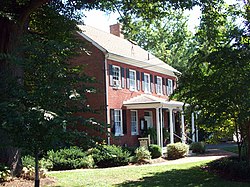Elkridge Furnace Complex
|
Elkridge Furnace Complex
|
|

Elkridge Furnace House, September 2009
|
|
| Location | 5730 and 5741-5745 Furnace Ave., 5735 Race Rd., Elkridge, Maryland |
|---|---|
| Coordinates | 39°12′47″N 76°42′12″W / 39.21306°N 76.70333°WCoordinates: 39°12′47″N 76°42′12″W / 39.21306°N 76.70333°W |
| Area | 6 acres (2.4 ha) |
| Architectural style | Greek Revival, Federal |
| NRHP Reference # | 90000635 |
| Added to NRHP | June 28, 1990 |
The Elkridge Furnace Complex is a historic iron works located on approximately 16 acres (6.5 ha) at Elkridge, Howard County, Maryland.
It comprises the six remaining buildings of an iron furnace which operated from the 18th century into the 1860s. Included are a large 2 1⁄2-story Federal/Greek Revival house constructed about 1835 as the residence of the furnace owner; a frame dwelling of approximately the same date which probably accommodated a manager or clerk; a 2 1⁄2-story company store and hotel or dormitory for furnace workers; two 19th-century outbuildings, possibly slave quarters; and a mid-19th-century brick duplex worker's dwelling. The 1835 Elkridge Furnace Inn is now operated as a restaurant and banquet facility.
It was listed on the National Register of Historic Places in 1990.
The banks of the Patapsco River had been unearthed to mind for iron stone, which resulted in the displaced sand and earth being dumped into the river, affecting its navigability. In 1753 a law was enacted to prevent the further filling in of the Patapsco River's shipping channel at Elkridge Landing and up to Baltimore.
Caleb Dorsey, an ironmaster aware of iron ore found in the Patapsco River valley, established Elkridge Furnace in 1751 and Dorsey's Forge upriver after 1761. Both projects took advantage of England's need for iron from the colonies which resulted in repealing all taxes on iron pigs in 1750 and iron bar in 1757 respectively. The Furnace bellows ran on water power; Water was diverted to a water wheel through a water race. The turning waterwheel drove a gear shift that powered the bellows which fanned the forge's charcoal fire. Dorsey's Forge and made nails and horseshoes against English law forbidding finished production in the Colonies. During the American Revolutionary War he made cannons and bayonets. In 1772, Samuel and Edward Dorsey inherited their father Caleb's estate. In 1787 Samuel died, there were 9 or more slaves that worked his operation at the time.
...
Wikipedia


